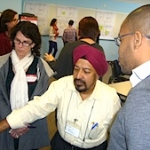When we think about looking for work, job listings, and placement services, career Web sites immediately jump to mind. But wouldn’t it be terrific to discover some of work’s secret hiding places?
immediately jump to mind. But wouldn’t it be terrific to discover some of work’s secret hiding places?
Well, there are exactly four. And they were revealed in a new book; Answering The Three Career Questions: Your Lifetime Career Management System, by author/career and management coach, Bruce Blackstone Hazen, President of Three Questions Consulting in the U.S.
We say “hiding places” because job-seekers often fail at searching for work. They look in physical locations such as offices, factories, or campuses. But work is reachable only by visiting the collective consciousness of a profession: by speaking with its practitioners, reading its journals and newsletters and blogs, listening to its spokespeople.
The best way to remember where work hides is with an acronym: PINT.
PINT stands for Problems, Issues, Needs, and Trends.
Problems means something’s broken or isn’t working right.
Issues means nothing’s broken yet, but rules, regulations, or conditions are changing.
Needs means something’s missing, or there’s an appetite for something new or different.
Trends means things are changing or moving in new directions, or people are behaving differently.
Together, the four invisible PINT elements generate work, all day every day — in every organization and in every market.
 We can all use a little extra help finding work. That’s why we’ve created a new tool to help you uncover where work hides.
We can all use a little extra help finding work. That’s why we’ve created a new tool to help you uncover where work hides.
The new PINT Value Proposition Designer™ matches your personal business model to the real engines of work, rather than to job listings and solicitations. It’s a key element of our upcoming workshops and master classes in Munich, Amsterdam, Brussels, and elsewhere.
